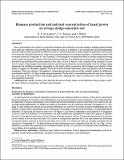Por favor, use este identificador para citar o enlazar a este item:
http://hdl.handle.net/10261/295237COMPARTIR / EXPORTAR:
 SHARE SHARE
 CORE
BASE CORE
BASE
|
|
| Visualizar otros formatos: MARC | Dublin Core | RDF | ORE | MODS | METS | DIDL | DATACITE | |

| Título: | Biomass production and nutrient concentration of kenaf grown on sewage sludge-amended soil |
Autor: | De Andrés Parlorio, Eusebio Francisco; Tenorio, J. L.; Walter, I. | Palabras clave: | Biomass yield Digested dewatered sewage sludge Dried-pelletized sewage sludge Fertilizer value Hibiscus cannabinus Nutrients Trace elements |
Fecha de publicación: | 2010 | Editor: | CSIC - Instituto Nacional de Investigación y Tecnología Agraria y Alimentaria (INIA) | Citación: | Spanish Journal of Agricultural Research 8(2): 472-480 (2010) | Resumen: | Due to increasingly strict control of wastewater treatment, the production of sewage sludge is surging and the problem of its disposal is therefore also growing. Recycling this waste as a fertilizer is an economically and environmentally attractive option. Determining the availability of macro- and micronutrients in these sludges is important if such wastes are to provide sufficient nutrients to crops while causing minimal environmental damage. A greenhouse study with two kenaf cultivars ('Everglades 41' and 'Tainung 2') was designed to evaluate the effects of sewage sludge processing mode on plant development, biomass yield, and nutrient availability. Two different processing modes of sludges (digested dewatered and pelletized-heat dried) applied at two rates, 10 and 20 Mg ha-1 were compared with inorganic N and a zero-N control. Plant height, basal stems diameter and biomass production increased slightly with the sewage sludge treatments but in different manners depending on the kenaf cultivar in question. Both sludges were similar in their ability to supply N to the plants. Apparent N recovery and N fertilizer equivalent value were greater in the low dosage treatments. Of the two cultivars, 'Everglades 41' showed greater mean values for all the variables studied. No differences were found in leaf P, K, Ca, Mg contents among treatments. The Zn and Cu concentrations were the only trace elements that increased in the leaf tissues with sludge application, although the values recorded were well below critical environmental thresholds. | URI: | http://hdl.handle.net/10261/295237 | DOI: | 10.5424/sjar/2010082-1202 | ISSN: | 1695-971X | E-ISSN: | 2171-9292 |
| Aparece en las colecciones: | (INIA) Artículos |
Ficheros en este ítem:
| Fichero | Descripción | Tamaño | Formato | |
|---|---|---|---|---|
| 2236.pdf | 68,75 kB | Adobe PDF |  Visualizar/Abrir |
CORE Recommender
SCOPUSTM
Citations
20
checked on 10-abr-2024
WEB OF SCIENCETM
Citations
16
checked on 25-feb-2024
Page view(s)
17
checked on 22-abr-2024
Download(s)
15
checked on 22-abr-2024
Google ScholarTM
Check
Altmetric
Altmetric
Este item está licenciado bajo una Licencia Creative Commons

